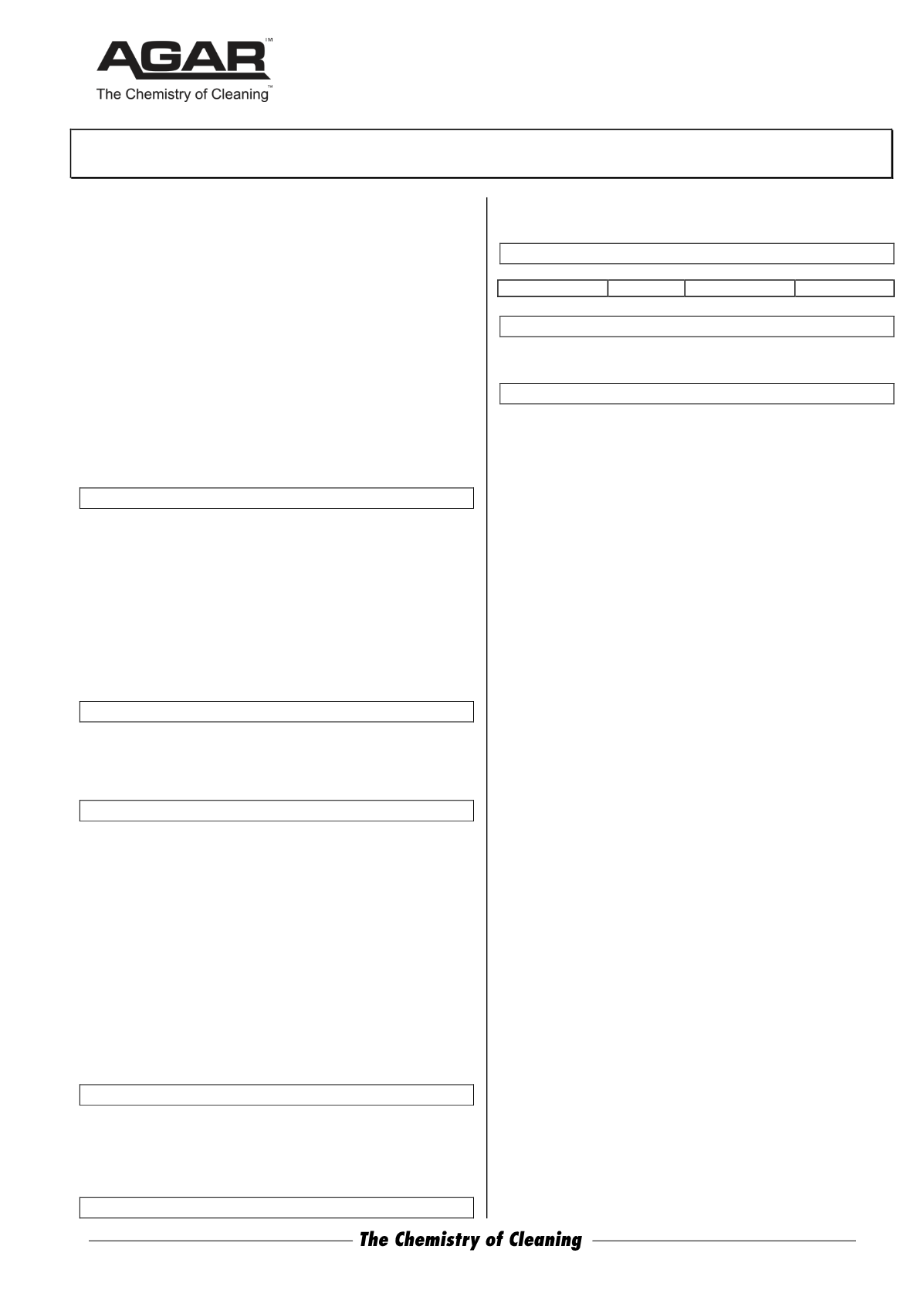

ABN 80 004 726 890 | MADE IN AUSTRALIA
Safety Data Sheet
Issued: July 19, 2012
Page 2 of 3
ULTRASTRIP
Atmospheric Contaminant Exposure Standard for:
2-butoxyethanol: TWA = 20 ppm, 96.9 mg/cu.m, ‘skin’
STEL = 50 ppm, 242 mg/cu.m.
ethanolamine: TWA = 3 ppm, 7.5 mg/cu.m.
STEL = 6 ppm, 15 mg/cu.m.
[Source: HSIS, Safe Work Australia 2012]
Engineering Controls: Mechanical ventilation: Not required
under normal conditions. Provide ventilation if vapour
concentrations exceed the exposure standards.
Personal Protection:
Gloves – Impervious natural rubber, butyl rubber, nitrile or
PVC gloves should be worn.
Note: Resistance of glove materials can vary. Evaluate
resistance under conditions of use and maintain PPE
carefully.
Eye protection – Safety glasses should be worn.
Respiratory – Not normally needed, but if exposure standards
are exceeded, wear air supplied mask or full face respirator.
9 PHYSICAL AND CHEMICAL PROPERTIES
Appearance: Colourless liquid
Odour: Faint solvent/almost odourless
pH = 11.0 ± 0.5
Vapour Pressure: N/K
Vapour Density: N/K
Boiling Point: 100
°
C
Freezing Point: < 0
°
C
Solubility in water: Infinitely miscible
Specific Gravity: 1
Evaporation rate: As water
% Volatile by vol: 60 - 80%
10 STABILITY AND REACTIVITY
Stable.
Hazardous polymerization: None.
11 TOXICOLOGICAL INFORMATION
Health Effects:
Acute -
Swallowed: Harmful. Corrosive.
Eye: Corrosive.
Skin: Harmful. Corrosive.
Inhalation: Harmful. Irritant.
Health Effects –
Chronic:
Skin contact may aggravate an
existing dermatitis. Inhalation may aggravate asthma.
Toxicity data: Not available for mixture.
2-butoxyethanol, oral LD50 (rat) = 1480 mg/kg
ethanolamine, oral LD50 (rat) + 2050 mg/kg
(Note: this data is from published information. Agar Cleaning
Systems does not carry out animal tests).
12 ECOLOGICAL INFORMATION
Ecotoxicity: Harmful effect due to pH shift.
Persistence and degradability: Biodegradable.
Mobility: -
Advice: Prevent entry into waterways and drains.
13 DISPOSAL CONSIDERATIONS
For disposal, refer to State Land Waste Management Authority.
14 TRANSPORT INFORMATION
UN No.: - not reg Class: -
Packg.Group: - Hazchem: -
15 REGULATORY INFORMATION
Poisons Schedule Number: Schedule 6.
16 OTHER INFORMATION
AICS Listing
: All components of Ultrastrip are listed on the
Australian Inventory of Chemical Substances (AICS).
Date: This SDS issued on July 19, 2012 shall remain valid for 5
years unless a new SDS is issued in the meantime. Please
contact Agar Cleaning Systems PL to ensure you have the
latest version of this product’s SDS.
Abbreviations and Definitions of terms used:
<
less than
>
greater than
AICS
Australian Inventory of Chemical
Substances
CAS
Chemical Abstracts Service (Registry
Number)
COD Chemical Oxygen Demand
deg C Degrees Celsius
g
gram
g/L grams per litre
HSIS
Hazardous Substance Information System
kg
kilogram
L
Litre
LC50
The concentration of a material (inhaled)
that will be lethal to 50% of the test animals.
LD50
The dose (swallowed all at once) which is
lethal to 50% of a group of test animals.
m3
Cubic metre or cu.m.
mg
milligram
mg/m3 milligrams per cubic metre
miscible A liquid that mixes homogeneously with
another liquid
N/A
Not applicable
N/K
Not Known
NIOSH
National Institute for Occupational Safety
and Health
non-haz Non- hazardous
PEL
Permissible Exposure Limit
ppb
Parts per billion
ppm Parts per million
‘Skin’
Ingredient may be absorbed through the skin
STEL Short term exposure limit
TLV
Threshold Limit Value
TWA
Time Weighted average
UN
United Nations (Number)
wt
weight
Please turn to page 3.


















